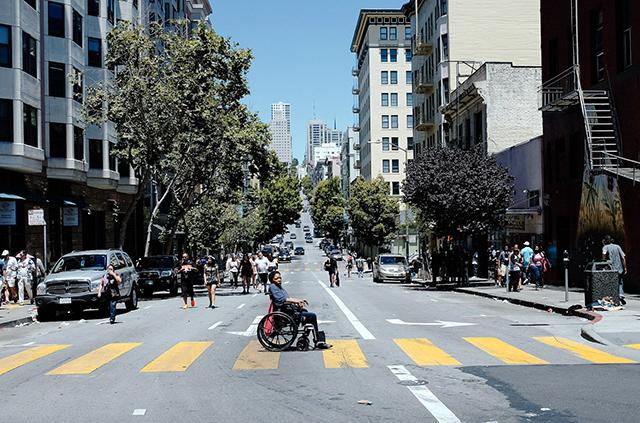
Universal accessibility means that everyone, no matter what your ambulatory capability, can safely use city streets and public spaces. It is egalitarian, and morally the right thing to do. Earlier this week Price Tags wrote about the unfortunate response of the City of San Francisco to a group of seniors that wanted more crossing time at a troublesome intersection. The city will lengthen the signal time, but still not at the national standard for seniors to safely cross the street.
Another horrifying example of a municipality doing the work right instead of doing the right work has just happened in Denver Colorado. Kyle Wolf, who is disabled was using his wheelchair to cross a street and “was just five feet from the curb at 19th and Lawrence Streets in downtown Denver when his wheelchair was struck from behind by an SUV. He had legally ventured out into the intersection during a walk signal but was carrying several items that kept slipping off his lap, thus slowing him down as he crossed. The pedestrian signal changed after just 20 seconds, and before he knew it, he’d been hit — injured — and his wheelchair totaled.”
The driver of the SUV was not charged, but Mr. Wolfe received a ticket from the police for his “failure to cross the street with the walk light signal”.Mr. Wolfe was hospitalized with injuries and was later released. Once again just like in San Francisco, the City of Denver trotted out that the nationally accepted Manual on Uniform Traffic Control Devices standard identifies that only fifteen per cent of the population walk at speed less than 3.5 feet a second, and therefore their twenty-second walk time for this cross walk was within the standard. However if an intersection crosswalk is being used by seniors or people with ambulatory impairments, the accepted crossing speed is established at 3 feet per second. And once again in Denver to minimize any impediment to motordom, the wheelchair user was charged with failure to cross the street in a timely manner while the SUV driver drove away with no charges.
What is wrong with us as a society that we are not encouraging our streets to be safe and to encourage the most vulnerable user, who often has the wheelchair as the sole way of transport? Even in the City of Vancouver all accidents are “pedestrian” so there is no notification on the report of whether the crash occurred with a wheelchair user or a walker. This makes the actual incidence of wheelchair crashes impossible to statistically collect, but it is suspected that wheelchair user crashes are underreported. A 2014 study by BMJ Open found that wheelchair users were three times more likely to die in crashes, and most of these users were killed crossing at intersections.
We are judged by how we treat the most vulnerable of our population. On a city street, bicyclists and pedestrians must have safe comfortable and convenient ways to travel. How do we move towards an inclusive standard that is universal for walkers, including seniors and those in wheelchairs?














Author
Reblogged this on Sandy James Planner.
“the City of Denver trotted out that the . . . standard identifies that only fifteen per cent of the population walk at speed less than 3.5 feet a second, and therefore their twenty-second walk time for this cross walk was within the standard”
I generally avoid preaching to the choir, but I am just stunned by this argument. Fifteen percent of the population *don’t count*?! How many people have to be just like you before you count as human?
Fifteen percent of the U.S. population are over the age of 65. Thirteen percent are under the age of 14. Thirteen percent are black. (Incidentally, 1% are in the top 1% by wealth; 10% in the top 10%.) Why don’t we disregard these groups too?
By this reasoning, none of us matter. I can guarantee that 100% of the population belong to a significant group making up less than 15% of the population.
I have seen this logic before about cars, cell phones, text readability, colour blindness, you name it. So far as I can tell, what it really means is that fifteen (or whatever) percent of the population is not like me: and if they can’t be bothered to be more like me, they bring it on themselves (where “it” could be anything from inconvenience to death). This is anti-human thinking. From what I can tell, it is widespread – maybe even held by a majority. What the heck is wrong with people?
Can’t delay those motorists. They suffer so much as it is, am i right? Gotta move those cars. What do you propose: slowing down traffic just because some mouthy cripple – who shouldn’t be out on the road in the first place – can’t hobble out of the way of important people in their cars as fast as he should? Like I said, cars cars carscarscars, cars cars cars cars to cars every single cars. I’m sure you can cars.
To think that this design “standard” is what will be upheld in court. That standard needs to be challenged.